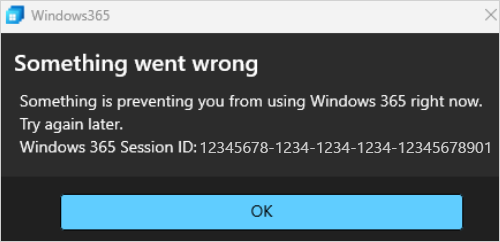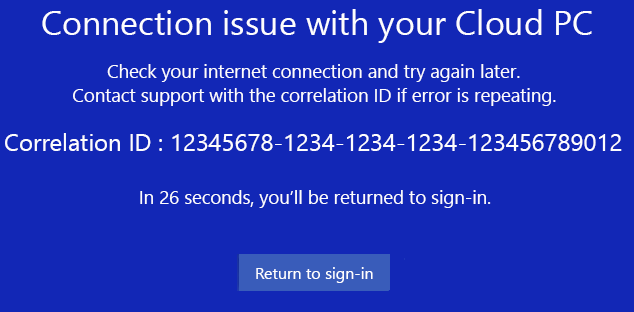Troubleshoot Windows 365 Boot
If you encounter problems while setting up or managing Windows 365 Boot devices, check below to find out how to troubleshoot.
User can't access the Cloud PC from the Windows 365 Boot physical device
If the user can't access the Cloud PC from the Windows 365 Boot physical device, try these troubleshooting steps:
- Check to see if you can sign in to the Cloud PC from either:
- The browser at windows365.microsoft.com.
- The Windows 365 app on another (non-Windows 365 Boot) device.
- If you can log into the Cloud PC from either method, then there's an issue with the Windows 365 Boot physical device. In this case, confirm that the physical device is correctly configured and has the requisite software versions. For more information, see Windows 365 Boot physical device requirements.
- Admins can try to manually click on Device sync to get the policies delivered faster on the device. Users can try to restart the device.
Physical device registry key configuration
Confirm that the physical device has been correctly configured to run Windows 365 Boot. Make sure that the following registry keys are set:
| Registry key name | Registry value name | Registry value |
|---|---|---|
| HKLM\Software\Microsoft\PolicyManager\current\device\CloudDesktop | BootToCloudMode | 1 |
| HKLM\Software\Microsoft\PolicyManager\current\device\WindowsLogon | OverrideShellProgram | 1 |
| HKLM\Software\Microsoft\Windows\CurrentVersion\SharedPC\NodeValues | 18 | 1 |
| HKLM\Software\Microsoft\Windows\CurrentVersion\SharedPC\NodeValues | 01 | 1 |
Physical device's versions of Windows 365, Azure Virtual Desktop Apps, and Windows
Windows 365 Boot requires that the physical device runs specific versions of both Windows 365 and Azure Virtual Desktop (HostApp) apps. To see which versions are installed, run the following PowerShell command in Admin mode:
Get-AppxPackage –AllUsers -name *MicrosoftCorporationII*
This command shows all the Microsoft-maintained apps (like QuickAssist, Microsoft Family, and so on) on the physical device. In order for Windows 365 Boot to work correctly, confirm the following versions:
- Windows 365 app version 1.1.162.0 or later.
- Azure Virtual Desktop (HostApp) app version 1.2.4159. or later.
Windows 365 Boot also requires the latest version of Windows 11.
Remove Windows 365 Boot from the physical device
If you're unable to identify the source of the issue, you can try to removing and re-adding Windows 365 Boot from the physical device.
Remove Windows 365 Boot from the physical device
- Sign in to the Microsoft Intune admin center > Groups > All groups.
- Select the group for your Windows 365 boot devices > Members.
- Select the physical device > Remove > Yes.
- Select Devices > All devices > select the physical device > Overview > Sync.
It takes about 10 minuets for the removal to finalize. After that, the physical device will no longer be set up for Windows 365 Boot.
Add Windows 365 Boot back onto the physical device
- Sign in to the Microsoft Intune admin center > Groups > All groups.
- Select the group for your Windows 365 boot devices > Members.
- Select Add members > select the physical device.
- Wait about 10 minutes.
- Select Devices > All devices > select the physical device > Overview > Sync.
The physical device will again be set up for Windows 365 Boot. Retest it to see if it's working.
Contact Microsoft support
If you're still unable to troubleshoot the problem, you can contact Microsoft support. To help expedite a solution, collect logs and session IDs beforehand.
Collect local logs
Windows 365 and Microsoft Entra ID log information is helpful to Microsoft support. Collect it beforehand from the following locations:
- C:\Users\{username}\AppData\Local\Temp\DiagOutputDir\Windows365\Logs
- C:\Users\{username}\AppData\Local\Temp\DiagOutputDir\RdClientAutoTrace
Put these logs in a zip file and provide it to the Microsoft support team for further investigation.
Windows 365 error and session IDs
When contacting Microsoft support about Windows 365 Boot issues, make sure to collect relevant IDs to help in the investigation.
On the physical device, get the CorrelationId, SessionID, or ActivityID.
Session ID
You can find the Windows 365 Session ID in error dialog boxes. For example, the error dialog box that says Something went wrong.

Correlation ID
You can find the Correlation ID in the interstitial screen displayed during a five-minute timeout.

Next steps
Feedback
Coming soon: Throughout 2024 we will be phasing out GitHub Issues as the feedback mechanism for content and replacing it with a new feedback system. For more information see: https://aka.ms/ContentUserFeedback.
Submit and view feedback for